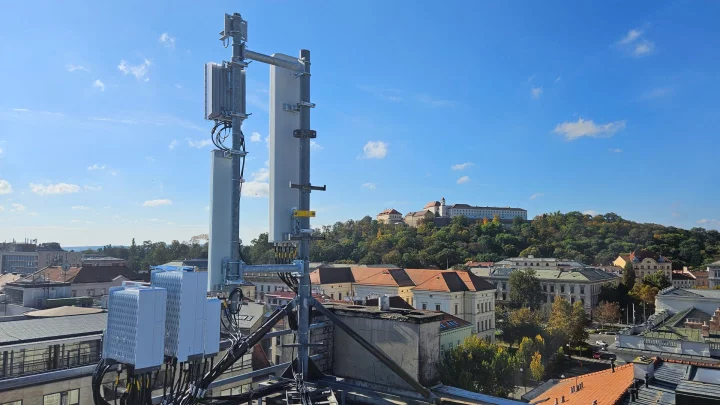In the South Moravian Region, O2 now covers 91.3% of the population and only a few locations remain. The modernization of the network took place here at a total of 607 base stations, with technicians devoting roughly 70 hours of work to each “bétéesé”. A total of 261 tons of material, mainly antennas and active elements of the network, as well as structural elements, were brought up to the heights. Cetin is building the network for O2.
As part of the tour, we looked at the roofs of the Santon Hotel near the Brno Dam and the house on Joštová Street in the city center. Both locations have multiple antenna nests and active elements for all seven frequency bands from 700 to 3700 MHz.
In terms of active RRU (remote radio unit) network elements, O2’s 5G network is built on Ericsson technology. Passive large antennas for some frequencies remained from Huawei. It is the RRUs that take care of processing the radio signal and adapting it for the part of the network where packets are already being sent.
Somewhere under the antennas, often under the roof one floor below, there is usually another part of the BTS, the server cabinet, more precisely the baseband. The connection to the RRU radios is here via optical cables. Backup batteries will keep the station running for about two hours in the event of a power outage.
Interestingly, the number of antennas or radios does not correspond to the number of frequencies. Some are combined, for example one RRU is for 700, 800 and 900 MHz frequencies, another for 1600, 1800 and 2100 MHz, another separate RRU for 2600 MHz (this frequency is TDDM, i.e. time multiplexed) and an RRU for 3.7 GHz there is already a common box with the antenna.
By the way, it’s not like one RRU is connected to one antenna. On the contrary, the frequency is distributed in such a way that these elements do not influence each other with their radiation and demand for power.
We tested the current speed on the roof, and in case of aggregation of several networks (700, 1800 and 3700), the mobile can achieve speeds of up to 1.1 Gb/s for downloads. We succeeded at the dam, but in the city center the speed was about a quarter lower. It must be added that we were standing behind the antennas during the measurement, which is not exactly an ideal place.
Of course, our 5G network is still the so-called 5G NSA (Non-Stand Alone), i.e. a network with a common core with LTE. A completely separate 5G (SA), which will no longer depend on LTE, or even 5G on millimeter waves is not yet in use in our country. Although O2 is already testing millimeter waves at its headquarters, and if you have a suitable mobile phone, you might be able to connect somewhere nearby.
Source: www.cnews.cz





